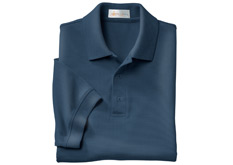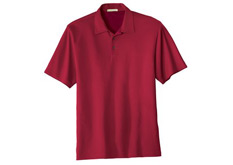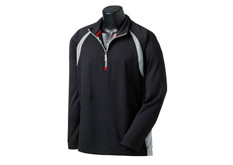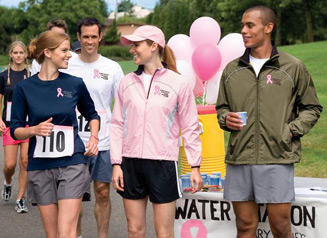A Guide to Performance Fabrics
Definitions and Key Terms to Aid in the Buying Process
As you begin preparing for Spring and Summer promotions, it is likely that you are considering purchasing some type of performance apparel. This is the second fastest growing category in wearables (just behind t-shirts), and although it is in high demand, many people are not really familiar with the diverse options available. I wanted to take this time to explain the different properties that make items "performance" pieces, so that you are able to choose your priorities and make a better informed decision on your promotional apparel this year.
Anti-Pill Pilling happens when fabric acquires a tangled ball of fibers on the surface as due to the abrasion during wear or continued friction or rubbing on the surface of the fabric. Anti-Pilling is a treatment applied to garments primarily to resist the formation of these little balls.
Antimicrobial This is a term used for garments that are able to resist the effects of microbial secretions put off by the human body. The property aides in odor control and also increases the life of the garment. An antimicrobial property can be created on different materials through the use of special fabric finishes aimed to protect the skin of the wearer and the textile substrate itself. These synthetic finishes are effective but will eventually wear off. There are some materials, such as bamboo, that have a natural antimicrobial property, allowing garments constructed from them to maintain the benefits throughout their lifetime.
Anti-Snag The tendency of garments to snag is particularly troublesome with lighter weight fabrics, like performance polyesters, which can overshadow all of the comfort features of such garments. To combat this problem, a finishing treatment was created which involves the application of a chemical solvent. This process improves the resistance of fabrics to snagging and inhibits pulling.
Anti-Static Special yarns or fabric finishes are used to eliminate or at least reduce the buildup of static electricity that occurs when the fabric experiences friction or rubbing. The chemicals used are largely inert and require a heat treatment for fixing on polyester fabrics. These anti-static agents also have a good soil release action, which is as permanent as the anti-static effect.
Breathability This refers to how well a fabric allows the movement of water or water vapor from one side to the other through capillary action, wicking, chemical or electrostatic action. The breathability rating is expressed in a gram measurement of how much vapor a square meter (G/M2) of fabric will allow to pass in a 24-hour period.
Moisture Wicking Fabrics with a wicking property do not actually stop the wearer from sweating. Instead they move moisture away from the wettest parts of the body and spread it throughout the shirt to the outer surface where it can most quickly be evaporated, allowing the wearer to stay dry and comfortable. There are different ways of constructing fabric to create this effect and just about every brand has their own name for their method. Nike GOLF has Dri-FIT®, Adidas has ClimaLite®, Devon & Jones has Dri-Fast™, and so on. While the technology for each varies and some are more effective than others, the basic concept of moisture wicking remains consistent.
Thermal Regulation This refers to fabrics that are engineered to maintain constant internal body temperature.
UV Protection UV Protective clothing accounts for UPF, which stands for Ultraviolet Protection Factor. This measures the amount of UV radiation that penetrates a fabric and reaches the skin. A fabric with a rating of 50 will allow only 1/50th of the sun's UV rays to pass through. The type of weave as well as the color of a fabric can affect the UPF rating. Clothing can also be treated with a chemical UV absorber during the manufacturing process to provide additional sun protection. These treatments often protect the fabric color from fading as well.
Vents These are an opening in a garment which assists breathability and can aid in ease of decoration, allowing the garment to be hooped and embroidered with no visibility on the inside lining of the garment. Some vents are tacked down and are for fashion purposes only.
Water Proof A term applied to fabrics whose pores have been closed and will not allow water to pass through. Special fabric finishes and sealed seams block moisture from penetrating a garment completely. In order to be completely water proof, specific seams are fused with waterproof tape. The waterproof rating is expressed in millimeters (MM) and refers to the amount of water a garment will hold before it leaks.
Water Repellent This refers to a fabric's ability to cause moisture to bead up and roll off the surface.
Water Resistant This effect is created with special fabric finishes that impede moisture from penetrating a garment for some period of time, but does not completely block it out. Water resistant garments typically lack seam sealing.
As you begin preparing for Spring and Summer promotions, it is likely that you are considering purchasing some type of performance apparel. This is the second fastest growing category in wearables (just behind t-shirts), and although it is in high demand, many people are not really familiar with the diverse options available. I wanted to take this time to explain the different properties that make items "performance" pieces, so that you are able to choose your priorities and make a better informed decision on your promotional apparel this year.
Anti-Pill Pilling happens when fabric acquires a tangled ball of fibers on the surface as due to the abrasion during wear or continued friction or rubbing on the surface of the fabric. Anti-Pilling is a treatment applied to garments primarily to resist the formation of these little balls.
Antimicrobial This is a term used for garments that are able to resist the effects of microbial secretions put off by the human body. The property aides in odor control and also increases the life of the garment. An antimicrobial property can be created on different materials through the use of special fabric finishes aimed to protect the skin of the wearer and the textile substrate itself. These synthetic finishes are effective but will eventually wear off. There are some materials, such as bamboo, that have a natural antimicrobial property, allowing garments constructed from them to maintain the benefits throughout their lifetime.
Anti-Snag The tendency of garments to snag is particularly troublesome with lighter weight fabrics, like performance polyesters, which can overshadow all of the comfort features of such garments. To combat this problem, a finishing treatment was created which involves the application of a chemical solvent. This process improves the resistance of fabrics to snagging and inhibits pulling.
Anti-Static Special yarns or fabric finishes are used to eliminate or at least reduce the buildup of static electricity that occurs when the fabric experiences friction or rubbing. The chemicals used are largely inert and require a heat treatment for fixing on polyester fabrics. These anti-static agents also have a good soil release action, which is as permanent as the anti-static effect.
Breathability This refers to how well a fabric allows the movement of water or water vapor from one side to the other through capillary action, wicking, chemical or electrostatic action. The breathability rating is expressed in a gram measurement of how much vapor a square meter (G/M2) of fabric will allow to pass in a 24-hour period.
Moisture Wicking Fabrics with a wicking property do not actually stop the wearer from sweating. Instead they move moisture away from the wettest parts of the body and spread it throughout the shirt to the outer surface where it can most quickly be evaporated, allowing the wearer to stay dry and comfortable. There are different ways of constructing fabric to create this effect and just about every brand has their own name for their method. Nike GOLF has Dri-FIT®, Adidas has ClimaLite®, Devon & Jones has Dri-Fast™, and so on. While the technology for each varies and some are more effective than others, the basic concept of moisture wicking remains consistent.
Thermal Regulation This refers to fabrics that are engineered to maintain constant internal body temperature.
UV Protection UV Protective clothing accounts for UPF, which stands for Ultraviolet Protection Factor. This measures the amount of UV radiation that penetrates a fabric and reaches the skin. A fabric with a rating of 50 will allow only 1/50th of the sun's UV rays to pass through. The type of weave as well as the color of a fabric can affect the UPF rating. Clothing can also be treated with a chemical UV absorber during the manufacturing process to provide additional sun protection. These treatments often protect the fabric color from fading as well.
Vents These are an opening in a garment which assists breathability and can aid in ease of decoration, allowing the garment to be hooped and embroidered with no visibility on the inside lining of the garment. Some vents are tacked down and are for fashion purposes only.
Water Proof A term applied to fabrics whose pores have been closed and will not allow water to pass through. Special fabric finishes and sealed seams block moisture from penetrating a garment completely. In order to be completely water proof, specific seams are fused with waterproof tape. The waterproof rating is expressed in millimeters (MM) and refers to the amount of water a garment will hold before it leaks.
Water Repellent This refers to a fabric's ability to cause moisture to bead up and roll off the surface.
Water Resistant This effect is created with special fabric finishes that impede moisture from penetrating a garment for some period of time, but does not completely block it out. Water resistant garments typically lack seam sealing.
$uccessful $eedlings:
 |
 |
 |
This Nexus Jacquard Polo combines a multitude of features together to make an ultimate performance product. In addition to having moisture wicking properties, U.V. protection and an antimicrobial finish, this shirt is North American made to boot. |
Constructed from the fast-growing renewable resource bamboo, this Birdseye Jacquard Sport Shirt resists UV rays, helps regulate body temperature, wicks away moisture and is antimicrobial. Bamboo is awesome because it contains these features naturally, avoiding the need for any chemical additives. |
Performance properties can be just as useful in Outerwear as they are in knits and t-shirts. This Half-Zip Pullover from Alo contains a moisture wicking property and also has an antimicrobial finish to prevent bacteria and odor buildup. |










